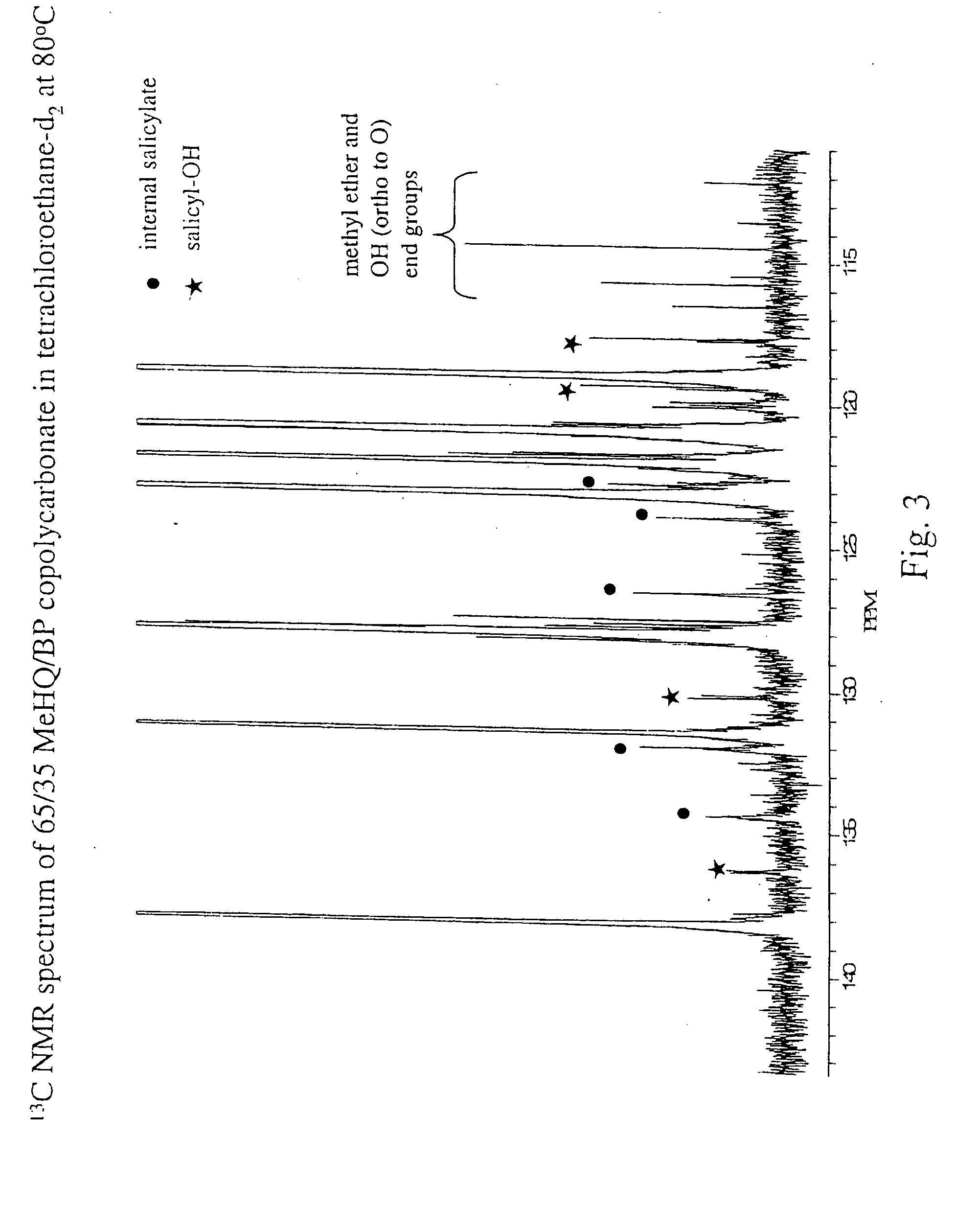Liquid crystal polycarbonates and methods of preparing same
a technology of liquid crystal polycarbonates and polycarbonate, which is applied in the direction of organic compound/hydride/coordination complex catalysts, physical/chemical process catalysts, manufacturing tools, etc., can solve the problem of preventing substantial commercial developmen
- Summary
- Abstract
- Description
- Claims
- Application Information
AI Technical Summary
Problems solved by technology
Method used
Image
Examples
example 1
Preparation of LCP with 45% HQ-45% BP-10% DHPE (Small Scale)
Step 1: Preparation of the Oligomer
[0070] A mixture of 15.408 g (0.14 mole) of hydroquinone, 6.289 g (0.031 mole) of 4,4′-dihydroxyphenylether, 26.060 g (0.140 mole) of biphenol and 104.705 g (0.317 mole) BMSC was placed in a 3-necked round bottom flask equipped with a mechanical stirrer, a temperature control probe and an adapter connected to a condenser / receiver for the vacuum distillation. To the mixture was added 620 ul of 1×10−3M aqueous solution of NaOH and 78 ul of 1.0M aqueous solution of tetramethylammonium hydroxide. The mixture was then immersed into an oil bath at 200° C. and the stirring started after about 15 min, when some of the solids had melted. After stirring for about 10-15 minutes, the reaction mixture became a clear solution. The internal temperature was 193° C. at this point. The reaction mixture started to turn cloudy after another 5 nin and slowly turned milky and become viscous. Gradually the vi...
example 2
Preparation of a 50 / 50 Mole % Biphenol / Hydroquinone Liquid Crystalline Co-polycarbonate (Large Scale)
[0072] Equipment: 12 liter Reaction flask equipped with a 6 inch flanged head assembly, a stainless steel agitator shaft and anchor stirrer, a high torque constant speed agitator motor. The head was equipped with a condenser assembly with receiving flask, a nitrogen inlet and a thermocouple probe for measuring melt temperature. The flask was heated with a dual zone heating mantle with two variable voltage controllers used for adjusting temperature.
[0073] Reaction Charge: Hydroquinone—660.8 grams (6.000 moles), Biphenol—1117.3 grams (6.000 moles) and Bis-(methylsalicyl)carbonate—4042.9 grams (12.240 moles).
[0074] Catalyst Charge: 3.0 ml of a 1.0 molar aqueous Tetramethyl ammonium Hydroxide solution and 1.2 ml of a 0.02 molar aqueous Sodium Hydroxide solution.
[0075] Start: Charge Hydroquinone, Biphenol and Bis-(methylsalicyl)carbonate to vessel blanketed with nitrogen. The reaction...
example 3
[0077] Samples were made with varying compositions as outlined in the table below using one of the method of example 1, 2 or 4 as set forth herein as indicated in the last column of the table. All of the compositions were determined to be liquid crystal materials by viewing microscopically between cross polarizers in the melt and observing birefringence. The Tm in the table was determined by differential scanning calorimetry and the temperature of the transition from solid to a fluid liquid crystal was determined using a hot stage microscope.
Composition2,1,HQ4,4′BPRSMeHQDHPEBPA6ND5NDTmEx604035615545341150503302455533514060343151341531725436103231454510297247.547.55318242.542.515302147.547.553021454510289247.547.553122454510296147.547.55325147.547.553151454510286150503091554532514060221435652424
PUM
| Property | Measurement | Unit |
|---|---|---|
| Shape | aaaaa | aaaaa |
Abstract
Description
Claims
Application Information
 Login to View More
Login to View More - R&D
- Intellectual Property
- Life Sciences
- Materials
- Tech Scout
- Unparalleled Data Quality
- Higher Quality Content
- 60% Fewer Hallucinations
Browse by: Latest US Patents, China's latest patents, Technical Efficacy Thesaurus, Application Domain, Technology Topic, Popular Technical Reports.
© 2025 PatSnap. All rights reserved.Legal|Privacy policy|Modern Slavery Act Transparency Statement|Sitemap|About US| Contact US: help@patsnap.com



